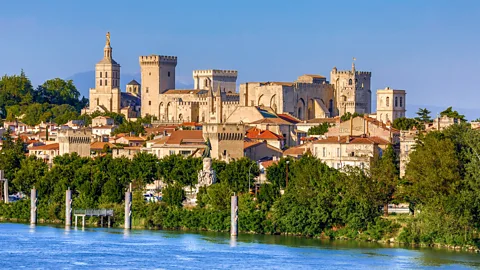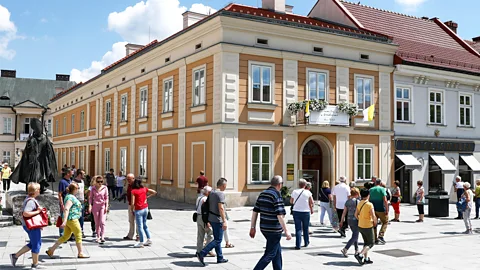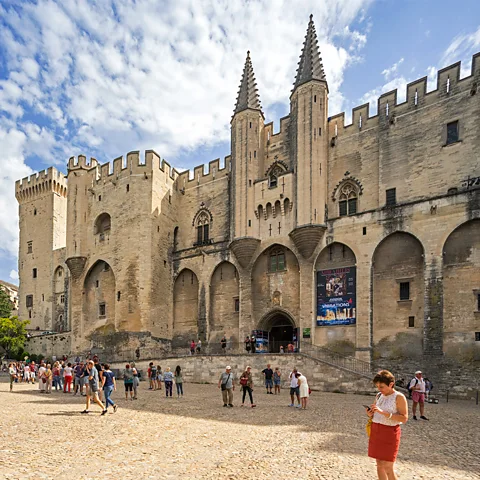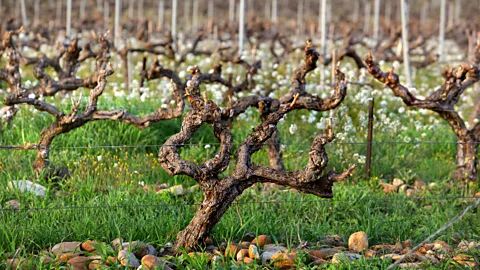From Chicago to Châteauneuf-du-Pape: What does a pope's hometown reveal?
 Getty Images
Getty ImagesFrom Polish pilgrimage trails to French vineyards, the places popes come from often gain new meaning. With the announcement of the first American pope, could Chicago be next?
When plumes of white smoke billowed across Rome's skyline last week, signifying the election of a new pope, the entire world looked towards Vatican City. But the story of the Catholic Church's new leader began far from St Peter's Square. In a historic first, the papacy now belongs to an American.
Pope Leo XIV – born 4,800 miles away in South Side Chicago – took to the balcony of St Peter's Basilica on 8 May to address a frenzied crowd of more than 40,000 people.
"The pilgrims in the square went wild," said Dr Miles Pattenden, an Oxford University lecturer and expert on the Catholic Church. "There was a lot of excitement but also gasps of surprise because a lot of people weren't expecting this name. The idea of an American pope has seemed pretty remote for most of the last half of the century. So, there was a sense of shock."
Pope Leo's first words to onlookers were not in English, however. He chose instead to speak in a mix of Italian and Spanish – the latter nodding to his 20+ year career in Peru – suggesting his identity spans more than one nation.
It begs the question: how does a pope's hometown shape his leadership – and how are those hometowns changed in return?
"There can't not be [a connection between pope and place]," said Nick Spencer, a senior fellow at Theos Think Tank. "However Catholic-with-a-small-'c' the church is, popes are from certain places and formed by certain experiences."
That was most obviously the case with Wadowice-born Pope John Paul II, says Spencer. "It’s inconceivable to think of his papacy without recognising his Polish upbringing and his life under two different totalitarian dictatorships in Poland."
 Getty Images
Getty ImagesA small town south of Krakow, Wadowice was once a quiet, multicultural Galician backwater. But since the elevation of its most famous son – the first non-Italian pope in 455 years, who served from 1978-2005 – it has transformed into a hub of Catholic pilgrimage.
"In the late '70s, Poland was already a pretty Catholic place, but the fact they had a Polish pope absolutely ignited it," Spencer said, explaining the impact of the papacy on Pope John II's hometown.
Today, visitors flock to the modest family home where he was born (which has been turned into a museum), as well as the parish church where he served as an altar boy and the square where he once played as a child.
Between 1996 and 2019, the number of international tourists to the museum more than doubled, according to Studies of the Industrial Geography Commission of the Polish Geographical Society, with a notable peak in 2005, the year of John Paul II's death. And in 2018, the museum celebrated its millionth visitor.
This speaks to the pull of a place, says Pattenden. "Pilgrimage is significant and important for Catholics. Partly because they believe in the enchantment of physical objects, including, for instance, the bodies and the remains of saints, and the items that the saints have touched. That's why you would go back to the birthplace of a saint because you can get grace from your proximity to those things."
Yet not all papal hometowns are drawn into the fold. Despite serving as Archbishop of Buenos Aires for more than a decade, Pope Francis, who died this April, travelled across numerous continents, visiting 68 countries during his 12-year papacy – but never returned to Argentina.
 Getty Images
Getty ImagesWhether a gesture of neutrality amid the country's fraught politics or a quiet declaration of global focus, his absence was noteworthy. In contrast to the pilgrimage energy that surrounds places like Wadowice, Francis's hometown remains, for now, a site of origin rather than worship.
Still, his Argentine roots shaped the way he was perceived. Francis became known as the "people's pope", something that came from his simple lifestyle, his work in the slums of Buenos Aires and his ease with ordinary people. His background helped reinforce a public image of humility, accessibility and concern for the working class.
John Paul II's Polish birthplace also had a big impact on his world view. He grew up and ministered under two oppressive regimes: first Nazi occupation, then Soviet-backed Communist rule. His papacy was defined by a commitment to human rights, religious freedom and moral resistance and he became a powerful voice against totalitarianism. During a landmark visit to Poland in 1979, his call to "be not afraid" resonated deeply with his countrymen, helping to inspire the Solidarity movement that would ultimately contribute to the collapse of Communist rule.
While Wadowice turned piety into pilgrimage, other papal places bear more unusual legacies. In Châteauneuf-du-Pape, a village nestled in the vineyards of southern France, traces of the medieval papacy live on in the local wine.
In the early 14th Century, the papacy temporarily relocated from Rome to Avignon in southern France, marking a significant shift in the Church's history. From 1309 to 1377, seven successive French popes resided in the city, escaping political instability in Rome and drawn by the influence of the French crown.
Often referred to as the "Avignon Papacy", this period saw the papal court flourish in grandeur, with its legacy still visible in its Palais des Papes, a Gothic fortress that once housed the spiritual heart of Catholicism. However, it also sparked controversy, with critics accusing it of corruption and excessive French sway.
 Getty Images
Getty ImagesOne pope, John XXII (from Cahors in southern France), commissioned a new summer residence in a nearby village – today known as Châteauneuf-du-Pape, or "The Pope's New Castle". His castle served as a fortified retreat and vineyard estate, taking advantage of the region's elevated position and favourable grape-growing conditions. The wine produced here still bears the papal crest of crossed keys of St Peter and a tiara, and tourists can join tours that blend this medieval papal history with wine tastings trips to centuries-old vineyards.
With the recent ascent of Leo XIV, attention has turned to his Chicago roots. In true US fashion, even his sporting allegiances made headlines, sparking debate over whether he supported the Cubs or the White Sox (it's the White Sox, his brother confirmed). But experts say his path may diverge from traditional expectations.
More like this:
• The country that’s famous for tolerance
• The great conclave secret: What do would-be popes eat?
• Testaccio: The foodie neighbourhood where Romans go to eat
"He is American but he [was] based in Latin America for most of [his life]," said Pattenden. "And he quite notably didn’t speak English when he did his initial greeting. That's all a sign to me that he's distancing himself from his Americanness."
Spencer added: "In addition to being an American pope, Leo's a Peruvian pope in a very profound way so that internationalism, one would imagine, is quite deep in the bone with him and it will be interesting to see if that has an effect."
Whether Chicago will embrace this moment remains to be seen. Its urban parishes and immigrant congregations may well lean into a newfound spiritual spotlight. Pilgrims may one day walk the streets of South Side as they now do in Wadowice. Or perhaps, like Francis's Buenos Aires, it will remain a quiet point of origin that's respected but not venerated.
What is clear is that the connection between papacy and place can linger long after the white smoke clears. It becomes a lens through which a pope's legacy is interpreted and reimagined. From wine labels in southern France to school trips in Poland, these places are transformed by proximity to power, by the long shadow of the papal office and by the faithful who come looking for something more than just a birthplace.
--
If you liked this story, sign up for The Essential List newsletter – a handpicked selection of features, videos and can't-miss news, delivered to your inbox twice a week.
